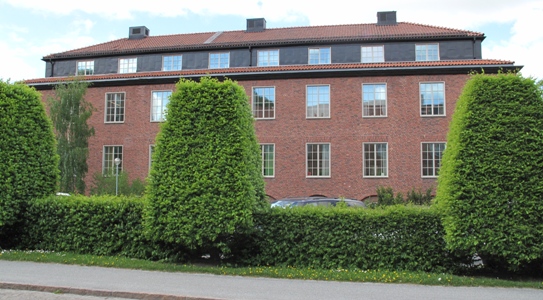KTH Campus
KTH Campus

Academic houses are responsible for removal of household waste and the tenant for other waste fractions. The tenant is responsible for removing bulky waste and pallets.
Evacuation alarm in case of fire
The building has smoke detectors that automatically trigger an evacuation alarm in case of fire smoke. The signal to evacuate is given via the siren and red flashing lights throughout the building.
In the event of a fire, call 112, as the evacuation alarm is not forwarded to the Rescue Service.
You can manually trigger the alarm yourself using push buttons in escape routes. Limit the source of the fire by closing windows and doors.
The lift must not be used in the event of a fire.
Of course, no two fires are the same and it depends on the circumstances how you should act in each individual case. Still, learn the basic rule:
ALARM - WARN - ALARM - EXTINGUISH
- save yourself and others around you, but don't take too many risks yourself
- warn others who may be in danger
- alert the emergency services by calling 112
- extinguish the fire if possible
Generally
Lighting in corridors and stairwells is controlled automatically via timers. After the set time, the lighting is switched on manually via a push button.
Around the clock, a few luminaires are lit per floor in stairwells and corridors, so-called led lighting.
Lighting in storerooms, WC, RWC etc. is switched on and off automatically via presence detectors.
Office etc
In offices, meeting and conference rooms, the lighting is switched on and off automatically via a presence detector. If this is not the case, the ignition must be activated manually via a push button located on the presence detector inside the door.
Generally
In order to obtain good air quality in the premises, the ventilation is adapted to the number of people and the equipment planned for the rooms. During very hot summer days, the indoor temperature is allowed to rise slightly.
Radiators are used for heating. Remember that the radiators must not be covered, e.g. in window niches with bars.
Office, meeting and seminar rooms
In these rooms, the normal temperature can be influenced somewhat via a room regulator (setpoint switch) inside the door. If you turn the switch towards red it will be warmer and if you turn it towards blue it will be colder.
Think of:
- that a manual change of the temperature can take a long time due to the thermal inertia of the building
- that windows should not be opened because it creates an imbalance in the ventilation
In break and seminar rooms, the ventilation is controlled automatically via temperature sensors. This means that the temperature is automatically adjusted according to the number of people in the room.